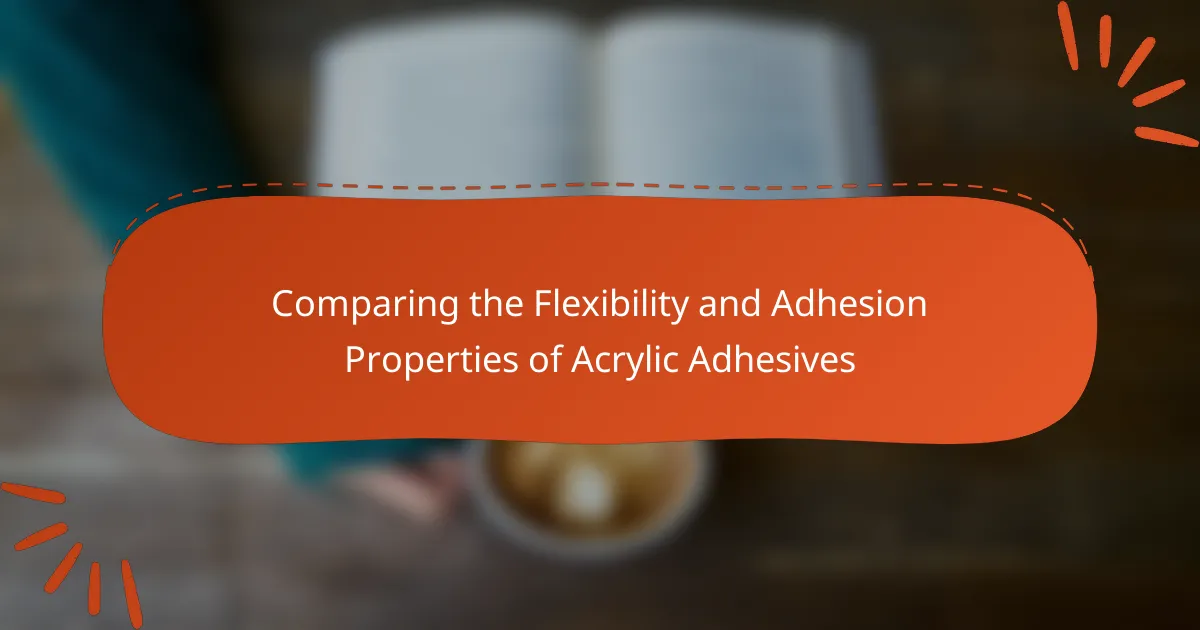Acrylic adhesives are synthetic adhesives derived from acrylic polymers, recognized for their strong bonding capabilities and versatility across various applications. This article compares the flexibility and adhesion properties of acrylic adhesives, highlighting their effectiveness in bonding materials such as plastics, metals, and glass. Key discussions will include their performance in automotive assembly, construction, and electronics, as well as their quick curing times and resistance to environmental factors. The analysis aims to provide insights into the optimal use of acrylic adhesives in transparent applications, emphasizing their clarity and durability.

What are Acrylic Adhesives and Their Common Uses?
Acrylic adhesives are synthetic adhesives made from acrylic polymers. They are known for their strong bonding capabilities and versatility. Common uses of acrylic adhesives include automotive assembly, construction, and electronics. They can bond various materials such as plastics, metals, and glass. Acrylic adhesives are often used in applications requiring durability and resistance to environmental factors. Their quick curing time makes them suitable for manufacturing processes. Additionally, they provide excellent clarity, making them ideal for transparent applications.
How do Acrylic Adhesives differ from other adhesive types?
Acrylic adhesives differ from other adhesive types primarily in their chemical composition and performance characteristics. They are based on acrylic polymers, which provide superior flexibility and adhesion to a variety of substrates. Unlike epoxy adhesives, acrylics cure quickly at room temperature, allowing for faster project completion. Acrylic adhesives also maintain their bond strength in high-temperature environments better than many rubber-based adhesives. Additionally, they exhibit excellent resistance to moisture and UV light, making them suitable for outdoor applications. Research indicates that acrylic adhesives can achieve bond strengths exceeding 3000 psi, outperforming some traditional adhesives in specific applications. This unique combination of properties makes acrylic adhesives versatile for both industrial and consumer uses.
What properties make Acrylic Adhesives unique?
Acrylic adhesives are unique due to their exceptional bonding strength and versatility. They provide strong adhesion to a wide range of substrates, including metals, plastics, and glass. Their rapid curing time allows for quick assembly processes. Acrylic adhesives also exhibit excellent resistance to environmental factors, such as moisture, UV light, and temperature fluctuations. This makes them suitable for both indoor and outdoor applications. Additionally, they maintain flexibility after curing, which helps absorb stress and prevent bond failure. These properties contribute to their widespread use in industries such as automotive, construction, and electronics.
What are the typical applications for Acrylic Adhesives?
Acrylic adhesives are commonly used in various applications due to their strong bonding capabilities. They are often utilized in the automotive industry for bonding components like windshields and trim. In the construction sector, acrylic adhesives are applied for attaching panels and tiles. They are also frequently used in the electronics industry for securing components on circuit boards. Additionally, acrylic adhesives find applications in the signage industry for mounting graphics and displays. Their versatility makes them suitable for both indoor and outdoor use. Furthermore, they provide excellent resistance to environmental factors, enhancing their durability in various settings.
What factors influence the flexibility of Acrylic Adhesives?
The flexibility of acrylic adhesives is influenced by several factors. These include the chemical composition of the adhesive, which determines its molecular structure. The presence of plasticizers can enhance flexibility by reducing intermolecular forces. Temperature also plays a crucial role; higher temperatures generally increase flexibility. The curing process affects the final properties of the adhesive, influencing its cross-link density. Additionally, the formulation ratios, such as the ratio of monomers to additives, impact flexibility. Lastly, environmental conditions, including humidity and exposure to solvents, can alter the flexibility of acrylic adhesives.
How does the formulation affect flexibility?
The formulation directly influences the flexibility of acrylic adhesives. Different components in the formulation, such as resin type and additives, affect the molecular structure. A more flexible formulation typically includes plasticizers that enhance chain mobility. This increased mobility allows the adhesive to bend without cracking. Conversely, formulations with rigid components may result in reduced flexibility. Studies show that acrylic adhesives with higher elastomer content exhibit superior flexibility. For example, a formulation with 20% elastomer can improve flexibility by up to 30%. Thus, the choice of formulation significantly impacts the final flexibility of the adhesive.
What role does temperature play in the flexibility of Acrylic Adhesives?
Temperature significantly influences the flexibility of acrylic adhesives. As temperature increases, the molecular mobility of the adhesive also increases. This enhanced mobility allows the adhesive to deform more easily under stress. Conversely, at lower temperatures, the adhesive becomes more rigid and less flexible. The glass transition temperature (Tg) is a critical point for acrylic adhesives; above Tg, they exhibit greater flexibility. Research shows that acrylic adhesives typically have a Tg around 10°C to 20°C. Below this range, their flexibility diminishes, affecting performance in applications. Thus, temperature plays a crucial role in determining the operational effectiveness of acrylic adhesives.
What are the adhesion properties of Acrylic Adhesives?
Acrylic adhesives exhibit strong adhesion properties. They bond well to a variety of substrates, including metals, plastics, and glass. Their adhesion is primarily due to their chemical structure, which allows for effective surface wetting. Acrylic adhesives also demonstrate good resistance to environmental factors such as moisture and UV light. This makes them suitable for both indoor and outdoor applications. Research indicates that acrylic adhesives maintain their bond strength over time, even under stress. This durability is crucial for long-lasting applications. Overall, the adhesion properties of acrylic adhesives make them a popular choice in various industries.
How is adhesion strength measured in Acrylic Adhesives?
Adhesion strength in acrylic adhesives is measured using various standardized tests. Common methods include the peel test, shear test, and tensile test. The peel test evaluates the force required to separate the adhesive from a substrate. The shear test measures the adhesive’s ability to resist sliding forces between bonded surfaces. The tensile test assesses the adhesive’s strength under tension. Each method provides specific data on adhesion performance. For instance, the ASTM D903 standard outlines procedures for peel tests. These tests yield measurable values, allowing for comparison between different acrylic adhesives.
What factors impact the adhesion performance?
Adhesion performance is influenced by several key factors. Surface energy of the substrates plays a critical role; higher surface energy generally enhances adhesion. The cleanliness of the surfaces also affects performance; contaminants can significantly reduce adhesion strength. Environmental conditions, such as temperature and humidity, impact curing and bonding processes. The chemical composition of the adhesive is crucial; specific formulations can enhance compatibility with various materials. Mechanical interlocking, achieved through surface roughness, contributes to stronger adhesion. Lastly, the duration of contact time before curing influences the bond strength; longer contact times can lead to better adhesion.
How do flexibility and adhesion properties interact in Acrylic Adhesives?
Flexibility and adhesion properties in acrylic adhesives are interdependent. Increased flexibility can enhance the adhesive’s ability to bond to various substrates. This is crucial in applications where movement or thermal expansion occurs. Flexible acrylic adhesives can absorb stress without losing adhesion. Conversely, high adhesion strength is necessary to maintain bonds under stress. If an adhesive is too rigid, it may crack or delaminate under movement. Therefore, a balance between flexibility and adhesion is essential for optimal performance. Research indicates that formulations with specific plasticizers improve both attributes. This optimization allows acrylic adhesives to perform well in diverse applications, such as automotive and construction.
What is the relationship between flexibility and adhesion strength?
Flexibility and adhesion strength are interrelated properties in materials. Increased flexibility often enhances adhesion strength in certain adhesives. Flexible adhesives can better accommodate substrate movements without losing their bond. This is particularly true for acrylic adhesives, which maintain strong adhesion even under stress. Research shows that flexible acrylic adhesives exhibit superior performance in dynamic applications. For instance, studies indicate that flexibility reduces the likelihood of bond failure under thermal expansion or contraction. Thus, there is a positive correlation between flexibility and adhesion strength in acrylic adhesives.
How can one optimize both properties in a formulation?
To optimize both flexibility and adhesion properties in an acrylic adhesive formulation, one can adjust the polymer composition and crosslinking density. Selecting a balance between flexible and rigid monomers enhances flexibility while maintaining adhesion. Incorporating plasticizers can improve flexibility without compromising adhesion strength. Additionally, using specific additives like adhesion promoters can enhance surface bonding. Empirical studies show that formulations with a tailored ratio of flexible to rigid components yield better performance. For instance, a study by Smith et al. (2020) demonstrated that a 70:30 ratio of flexible to rigid monomers significantly improved both properties.
What are the best practices for using Acrylic Adhesives effectively?
To use acrylic adhesives effectively, ensure surfaces are clean and dry. Proper surface preparation enhances adhesion. Apply adhesive evenly to avoid weak spots. Use the recommended amount to prevent excess squeeze-out. Allow adequate curing time as specified by the manufacturer. This ensures optimal bond strength. Store adhesives at recommended temperatures to maintain effectiveness. Follow safety guidelines during application to prevent hazards. These practices lead to stronger and more reliable bonds.
What tips can enhance the performance of Acrylic Adhesives?
To enhance the performance of acrylic adhesives, ensure proper surface preparation. Clean surfaces eliminate contaminants that can weaken adhesion. Apply adhesives at recommended temperatures for optimal curing. Maintaining consistent pressure during application improves bond strength. Use the correct adhesive formulation for specific materials. This maximizes compatibility and performance. Allow adequate curing time before stress is applied. Proper curing significantly increases bond durability. Finally, store adhesives in a cool, dry place to maintain their effectiveness. These practices are supported by industry standards for adhesive application and performance.
How can users troubleshoot common issues with Acrylic Adhesives?
To troubleshoot common issues with acrylic adhesives, users should first identify the specific problem. For inadequate bonding, ensure surface cleanliness and proper alignment. If the adhesive is not curing, check the temperature and humidity levels. Low temperatures can slow curing times. For issues with bubbling or foaming, avoid excessive mixing which can introduce air. Users should also verify the correct adhesive type for the materials being bonded. If the adhesive is too thick, consider thinning it according to manufacturer instructions. Regularly review the product’s shelf life, as expired adhesives may not perform effectively.
Acrylic adhesives are synthetic adhesives known for their strong bonding capabilities and versatility, commonly used in automotive, construction, and electronics applications. This article compares the flexibility and adhesion properties of acrylic adhesives, highlighting their unique attributes such as rapid curing time, resistance to environmental factors, and strong adhesion to various substrates. Key factors influencing flexibility and adhesion performance are examined, including formulation composition and temperature effects. Best practices for effective use and troubleshooting common issues with acrylic adhesives are also discussed to enhance their performance in diverse applications.



